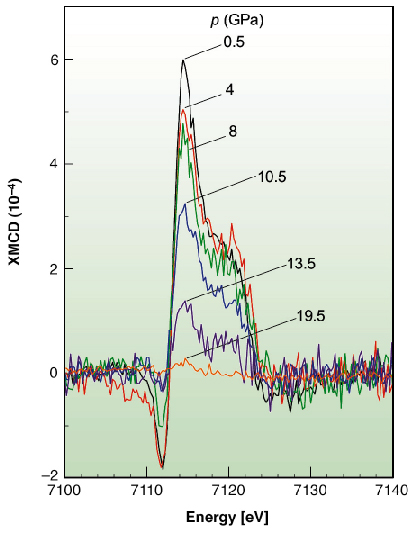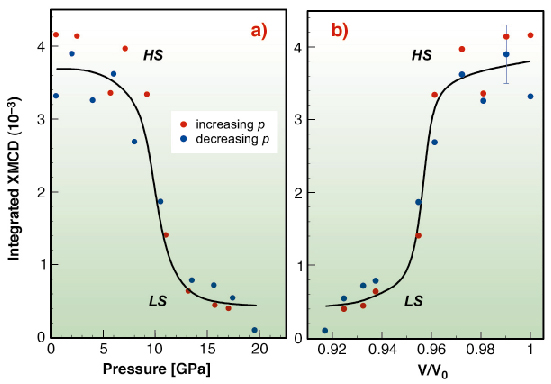- Home
- Users & Science
- Scientific Documentation
- ESRF Highlights
- ESRF Highlights 2005
- X-ray Absorption and Magnetic Scattering
- Magnetic Instabilities in Fe<sub>3</sub>C (Cementite) Particles Observed with Fe <em>K</em>-Edge X-ray Circular Dichroism under Pressure
Magnetic Instabilities in Fe<sub>3</sub>C (Cementite) Particles Observed with Fe <em>K</em>-Edge X-ray Circular Dichroism under Pressure
Fe3C is a common hardening constituent in carbon steels, and its amount in steel can be regulated by various heat treatment processes. The desired quantity depends on the particular application of the product. There is also a completely different aspect to Fe3C in addition to it being a steel component. Fe3C is ferromagnetic below the Curie temperature TC of about 485 K with interesting magnetic properties featuring the invar effect, whereby the temperature dependence of its thermal expansion coefficient is nearly identical to that of the archetype Invar alloy Fe0.65Ni0.35[1].
In the ground state of Invar type alloys, the atomic volume dependence of the binding energy exhibits a magneto-volume instability. This instability occurs between a high-spin (HS) state, which is the state of lowest energy in the vicinity of the equilibrium volume V0, and a low-spin (LS) state. At volumes about 5% less than V0, the LS state becomes energetically favorable over the HS-state. The presence of the LS-states, therefore, provides for an enhanced anharmonicity towards volumes smaller than the equilibrium volume (“negative” anharmonicity), so that as the temperature increases, the atoms can approach one another closer than in a normal material. This results in a compensation of the normal lattice expansion, thereby leading to a vanishing thermal expansion coefficient.
Since Fe3C shows the invar effect, its ground state binding energy is also expected to feature a magneto-volume instability. The direct method of detecting the presence of a magnetic instability that is coupled to the lattice degrees of freedom is to measure a magnetisation related parameter under applied pressure. We have, therefore, studied the pressure dependence of the X-ray magnetic circular dichroism (XMCD) of Fe3C. The measurements were carried out on the ID24 beamline.
 |
|
Fig. 127: The XMCD spectrum of Fe3C around the Fe K-edge. |
Figure 127 shows the XMCD spectra from ambient pressure up to about 20 GPa taken on increasing pressure. The data taken on decreasing pressure are similar. The overall intensity of the spectra diminishes as the pressure increases, and only a remanent feature remains at 19.5 GPa. The integrated XMCD is plotted as a function of applied pressure in Figure 128a. A clear HS-LS transition is observed starting at around 8 GPa, after which the XMCD drops rapidly and is reduced by about 80% at 13 GPa. Figure 128b shows the same plot as a function of reduced volume V/V0, which is calculated using the results of equation of state studies on Fe3C [2]. The transition occurs at a volume reduction of 4-5%; very similar to the case of Fe65Ni35.
 |
|
Fig. 128: The integrated XMCD plotted as a function of a) the applied pressure and b) the reduced volume. |
Since the p electrons of the carbon atom at the interstitial sites in Fe3C are strongly hybridised with the d band of Fe, the valence electron concentration e/a per metal atom of Fe3C can be estimated as the concentration weighted sum of the total number of s, p, and d electrons, namely as [(0.75 x 8 + 0.25 x 2)/0.75] = 8.67. It is interesting to note that this value is almost exactly the same as that for Fe65Ni35, and corresponds to a valence electron concentration where invar related magnetovolume effects are largest.
In conclusion, pressure dependent XMCD spectroscopy at the Fe K edge proves to be a useful tool to observe volume driven magnetic instabilities in systems that incorporate Fe. By probing the magnetic degree of freedom with this method, we find direct evidence for the presence of a magnetovolume instability in Fe3C. These instabilities are expected to be the source of the Invar-typical features observed in the temperature dependence of the thermodynamical parameters for this material.
References
[1] W. Pepperhof and M. Acet, Constitution and Magnetism of Iron and its Alloys (Springer-Verlag, Berlin, Heidelberg, 2001).
[2] E. Duman, M. Acet, T. Hülser, E. F. Wassermann, B. Rellinghaus, J. P. Itié, and P. Munsch, J. Appl. Phys. 96, 5668 (2004).
Principal publication and Authors
E. Duman (a), M. Acet (a), E. F. Wassermann (a), J. P. Itié (b), F. Baudelet (c), O. Mathon (d) and S. Pascarelli (d), Phys. Rev. Lett. 94, 075502 (2005).
(a) Experimentalphysik, Universität Duisburg-Essen (Germany)
(b) Physique des Milieux Condensés, CNRS-UMR 7602, Université Paris VI (France)
(c) Syncrotron Soleil (France)
(d) ESRF



